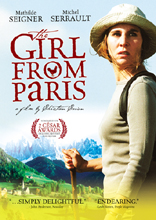|
Reviews of Recent Independent, Foreign, & Documentary Films in Theaters and DVD/Home Video
THE GIRL FROM PARIS
A white-collar Parisian, Sandrine
Dumez (Mathilde Seigner), suddenly announces to her mother she
wants to become a farmer. Upon completing a two-year agricultural school,
Sandrine purchases the farm of widower Adrien (Michel Serrault ), who
remains on the property until he is able to move away.
Adrien watches bitterly as she turns his family’s farm into a tourist
attraction complete with a hotel and tours for children. He scoffs at
her degree and her belief that she will be able to live
on the remote farm alone during the harsh winter. Throughout this battle of wills, Sandrine,
however, works to win him over with her charm and determination. The Girl from
Paris begins strongly by pulling viewers in
during its first moments and ends with a slightly surprising
conclusion. Mathilde Seigner gives a charming and simple performance, as does Michel Serrault.
The duo’s relationship is intriguingly vague at times. Whether Adrien looks at
Sandrine as the daughter he never had, a young attractive crush or a
little of both remains unclear.
The scenery of the Rhône-Alps region is beautiful, and the premise of the
traditional farmer working against the school-educated one
rings true as the conundrum of modern agriculturists. And the film doesn’t hold back, graphically
depicting many of rural life’s harsh realities, some of which are not for the faint of heart.
DVD Extras: The featurette of Christian Carion’s return to the farm used
in the film is fascinating for anyone interested in the beautiful
setting. He discusses the importance of the film to
him and his desire to use childhood memories of his dad, a chicory farmer, as inspiration. Carion
visits the goat shed and is surprised to see it
empty. The goats’ owner explains the animals had to be sold but seeing the goats onscreen in the film was
good closure.
Equally interesting are the behind-the-scenes clips,
especially where a camera is attached to a small
helicopter to film the opening sequence. And the alternative ending is actually
better than the original ending. It brings the story full circle in a
way that the film’s final moments fail to do.
Lauren Hines
|
